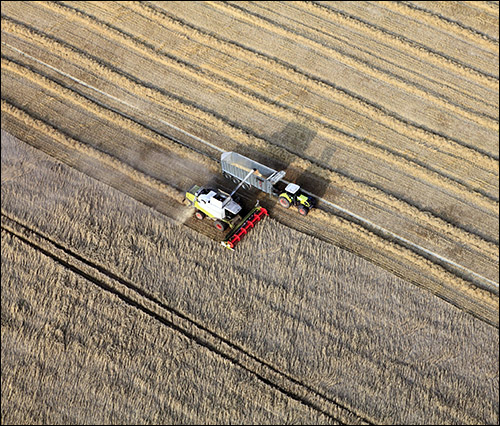Accurately tracking the weight of grain or other crops, starting at the point of harvest, is an important business process for growers around the world. In 2011, Fliegl Agrartechnik, a German manufacturer of agricultural trailers, tanks and other agricultural logistics equipment, debuted its Fliegl Axle Weighing System (FWS), a solution that can be retrofitted into equipment from vehicles made by Fliegl or other manufacturers, in order to help grain producers automate the process.
The movement of the grain starts with a combine or other harvesting equipment. A large shoot, also known as a grain slide, extends from this in-field machine onto a transfer vehicle—a type of tractor with a very large cargo container that travels next to the combine or harvester. The FWS weighs the grain as it is loaded onto the transfer vehicle. Once its container is full, an employee drives the transfer vehicle to a roadway, where the grain slide mounted on that vehicle moves the cargo onto a transport truck that will move it off the farm. Digital scales on both the transfer vehicle and the transport truck document the load weights.
Precisely measuring the harvest weight is important for a simple reason, explains Franz Höpfinger, Fliegl Agrartechnik’s development manager. Producers are paid based on how much they grow. But the ability to accurately weigh what is harvested is also an important security measure, he says, because in regions of the world where workers earn very low wages but the value of grain is high, there is always the chance that some of the grain “might disappear.” Therefore, Höpfinger says, “farm managers want to know how much grain came off the field, so you have to weigh it in the field.”
Additionally, to comply with food-security programs that require growers to track products’ movement from field to fork, producers currently need to manually document the identification number of the combine in the field from which the crop was collected, as well as the IDs of the trucks onto which the harvest is then loaded for transport off the farm.
For all of these reasons, Fliegl has developed an extension to the FWS platform, known as Fliegl Tracker, which uses Bluetooth technology to identify harvesting equipment as well as the truck. The company began developing the Tracker at the end of 2014, and expects its customers will begin deploying the solution this coming summer.
Before developing the Tracker, Höpfinger says, Fliegl conducted audits of the manual tracking system currently used, and found that around a third of the data entries made by transfer vehicle operators are incorrect. They are simple errors, such as transposed numbers, but they can cause significant problems in the tracking programs.
The earliest prototypes of the system employed active RFID tags made with a Nordic Semiconductor 2.4 GHz transceiver system-on-a-chip (model nRF24LE1). But last year, Höpfinger and his team decided to move to Bluetooth Low Energy (Bluetooth Smart) beacons, because they wanted hardware that could support a standard protocol. The Tracker consists of beacons and a beacon gateway made by original equipment manufacturers that Höpfinger declines to name, though he notes that they both use Nordic’s nRF51822 system-on-a-chip.
The beacon is designed to be mounted on the transport truck, where it transmits a unique ID number that is received by the gateway. The gateway, which is mounted on the transfer vehicle, forwards that ID to the FWS management software, where it is associated with orders related to the crop being harvested, including a record of the transport truck’s current payload and the total amount that it is commissioned to haul. This enables the conveyance equipment on the transfer vehicle to automatically move the correct amount of product into the truck’s container, without the need for any operator intervention. This is possible through an integration between the FWS software and a mechanism that controls the grain slide through which the product is transferred, as well as through integration with the customer’s farm-management system software. Höpfinger says Fliegl has created software that integrates the FWS with all major farm-management system software.
For what will become the second generation of the Tracker hardware, Fliegl is working with a contract manufacturer to develop bespoke beacons that are both ruggedized (since the application requires that the devices operate within a wide range of temperatures, as well as being waterproof and resistant to some mechanical abuse) and able to run on replaceable AA batteries. “What we’ve found on the market,” Höpfinger explains, “are beacons that are either totally shielded [from the environment] but do not have a battery that can be replaced, or have a changeable battery but are not rugged enough for our application.”
The first-generation beacons, which Fliegl is selling for $25 each, have a battery that is expected to last for about five years when used regularly.
At the Consumer Electronics Show, held earlier this month, the Bluetooth Special Interest Group (SIG) named the Fliegl Tracker its overall winner in its 2016 Bluetooth Breakthrough Awards contest.


